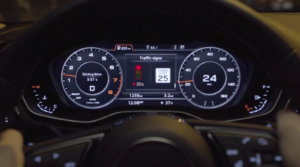Audi of America, the Virginia Department of Transportation (VDOT) and Qualcomm Technologies, Inc., Wednesday revealed plans for initial deployments of Cellular Vehicle-to-Everything (C-V2X) communication on northern Virginia roads. They expect to employ advanced wireless communications to enhance vehicle safety by using the same portion of the 5.9 GHz band the FCC has proposed to allocate for C-V2X.
In line with the Federal Department of Transportation’s announcement to establish a First Responder Safety Pilot Program, the organizations’ combined efforts are designed to focus on improving safety for construction workers and motorists. The initial deployment is expected to take place on certain roads in Virginia beginning in the third quarter of this year.
Unique properties of basic C-V2X will be used to deliver work zone warnings on highways as well as signal timing information on approaches to intersection signals on arterial roads. In both cases, C-V2X communications can help deliver critical safety messages between vehicles and infrastructure with minimal latency, while less time-sensitive alerts are designed to be provided via C-V2X using the cell network.
The northern Virginia initial deployment is designed to involve two primary use cases:
- Work zone warnings, which the organizations feel is an important use case on highways, featuring a Qualcomm® 9150 C-V2X chipset via an in-vehicle display in Audi Q8 SUVs designed to deliver a graduated warning. The last link is a low-latency, reliable warning to drivers of the workers’ physical presence.
- On arterial roadways, the signal phase and timing (SpaT) from a traffic signal, will be transmitted with a Qualcomm 9150 C-V2X chipset to Audi Q8 SUVs. These vehicles have the Audi Traffic Light Information (TLI) service that can provide drivers a countdown to the green light. C-V2X from the traffic signal can also provide direct information to the Audi Q8, which will be used by the TLI system to fine-tune the countdown information of the signal phase and timing.
In response to the news, FCC Chairman Ajit Pai stated: “The cars and trucks of the future will use wireless spectrum and advanced technologies to keep us safer on the road. C-V2X, is a new and promising technology that is gaining momentum in the automotive industry as it enables communications between cars, infrastructure, cyclists, pedestrians, and road workers.”
Pai noted the companies’ have an experimental license from the FCC. The current rules governing the 5.9 GHz band lock permit only Dedicated Short Range Communications (DSRC) use. Though some automotive companies use DSRC for experimentation, the FCC considers that portion of the band underused. The agency voted in December on a proposal to designate 20 megahertz for C-V2X deployment in the 5.9 GHz band.
“If this proposal is adopted, it would be a significant step forward for automotive safety, since there is currently no spectrum designated for C-V2X,” Pai stated. “Americans on the move would be the beneficiaries—but only if the FCC takes action and leaves the failed status quo behind.”





Reader Interactions